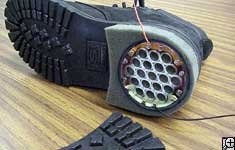|
|
|
|
|
Last Words
 Shoe Boots Up Electronic Devices
Shoe Boots Up Electronic Devices
By Irene Brown, Discovery News
02/10/2001
Walking a mile in another man's shoes may soon generate more than empathy - it could recharge your cell phone.
Backed by Defense Department research funding, a California company is working on lacing a boot with electroactive polymers to convert the mechanical energy of walking into electric power to charge up gadgets, batteries and other devices.
"No one had ever generated electricity with the polymers before," said SRI International program director Ronald Pelrine, who is overseeing the boot generator project.
The polymers are thin films of rubbery materials with electrodes positioned on opposite sides. As the film is compressed and released, the electrodes move closer and farther apart, increasing the distance between positive and negative electrical charges, which generates electricity. This energy can be tapped immediately or converted into power for later use.
As little as 10 grams of the material is needed to generate the charge. SRI has been testing a pair of shoes in a laboratory and so far has generated a steady half-watt of power in a squash-and-release demonstration of the boot. Ultimately, Pelrine believes two- to three watts of power can be generated, which would be enough to power up small electronics devices and recharge batteries.
The military, which is funding the project through January under an Energy Harvesting Program, is interested in the technology for four applications: to recharge batteries; to serve as an emergency backup power source; to power equipment in the boot, such as a navigation tool; and to possibly cushion or otherwise augment the walk of the soldier, who may have to transverse long distances with 70 pounds of equipment on his back.
"Soldiers today are quickly getting overwhelmed with batteries, particularly with what you'd like to equip them with, " said Pelrine.
The Defense Advanced Research Projects Agency, or DARPA, has contributed about $2.6 million of the approximately $10 million spent so far. SRI's other partners in the project, which began about 10 years ago, have included the U.S. Office of Naval Research, a Japanese government research agency, and corporations. The firm currently is in negotiations with shoe manufacturers and other companies to spin off the technology for commercial applications.
The polymers also can work in reverse, serving as actuators rather than generators to convert electrical energy into mechanical muscle. The applications for motors, robotics devices, pumps, valves and other devices are virtually endless.
SRI, for example, is investigating using the polymers to design and build miniature air vehicles propelled by tiny bird-like wings, which, at that size, are more energy efficient than conventional propellers.
"Just your car has about 50 actuators in it," said Pelrine. "This technology is fairly significant - It's not just about boot strikes."
Original article apperared at Read the full article at Discovery
Links:
SRI
More unconventional chargers
More unconventional chargers
More unconventional chargers
One more charger
|
|
|